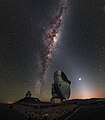Fil:La Silla Dawn Kisses the Milky Way.jpg

Originalfil (5 784 × 6 629 pixlar, filstorlek: 9,81 Mbyte, MIME-typ: image/jpeg)
| Denna fil tillhandahålls av Wikimedia Commons. Informationen nedan är kopierad från dess filbeskrivningssida. |
Sammanfattning
| BeskrivningLa Silla Dawn Kisses the Milky Way.jpg |
English: La Silla Dawn Kisses the Milky Way
This picture was taken just before dawn at the La Silla Observatory, in outskirts of the Chilean Atacama Desert. A layer of orange hovering over the horizon announces the imminent arrival of the Sun. These first hints of daylight are kissed by the Milky Way, which stretches out across the entire night sky. This view of our home galaxy is covered with dark patches, formed from dust particles blocking the light behind them. In front of this cosmic scenery you can see some of the observatory’s telescopes. The closest is the Swedish–ESO Submillimetre Telescope (SEST), whose dish measures 15 metres across. It was decommissioned in 2003 and replaced by the Atacama Pathfinder EXperiment telescope (APEX) and the Atacama Large Millimeter/submillimeter Array (ALMA). On the plateau in the background stands the ESO 3.6-metre telescope, with the Coudé Auxiliary Telescope (CAT) right behind it. SEST seems to be pointing at an extremely bright object: This is Venus, one of our neighbouring planets. Venus is lit up by the Sun and outshines all of the stars in the night sky. The triangular white glow that reaches up from the horizon through Venus is called zodiacal light. Zodiacal light is sunlight scattered by dust in the ecliptic — the plane of Earth’s orbit around the Sun. |
| Datum | |
| Källa | https://www.eso.org/public/images/potw1611a/ |
| Skapare | ESO/B. Tafreshi (twanight.org) |
Licensiering
 |
This media was created by the European Southern Observatory (ESO).
Their website states: "Unless specifically noted, the images, videos, and music distributed on the public ESO website, along with the texts of press releases, announcements, pictures of the week, blog posts and captions, are licensed under a Creative Commons Attribution 4.0 International License, and may on a non-exclusive basis be reproduced without fee provided the credit is clear and visible." To the uploader: You must provide a link (URL) to the original file and the authorship information if available. |
Denna fil har gjorts tillgänglig under licensen Creative Commons Erkännande 4.0 Internationell.
| |
Bildtexter
Objekt som porträtteras i den här filen
motiv
14 mars 2016
Filhistorik
Klicka på ett datum/klockslag för att se filen som den såg ut då.
| Datum/Tid | Miniatyrbild | Dimensioner | Användare | Kommentar | |
|---|---|---|---|---|---|
| nuvarande | 14 februari 2024 kl. 15.21 |  | 5 784 × 6 629 (9,81 Mbyte) | C messier | full size |
| 23 mars 2016 kl. 10.43 |  | 1 280 × 1 467 (470 kbyte) | Jmencisom | User created page with UploadWizard |
Filanvändning
Följande sida använder den här filen:
Global filanvändning
Följande andra wikier använder denna fil:
- Användande på en.wikipedia.org
- Användande på es.wikipedia.org
- Användande på uk.wikipedia.org
Metadata
Den här filen innehåller extrainformation som troligen lades till av en digitalkamera eller skanner när filen skapades. Om filen har modifierats kan det hända att vissa detaljer inte överensstämmer med den modifierade filen.
| Erkännande/leverantör | ESO/B. Tafreshi (twanight.org) |
|---|---|
| Källa | European Southern Observatory |
| Kort titel |
|
| Bildtitel |
|
| Användningsvillkor |
|
| Exponeringstidpunkt | 14 mars 2016 kl. 06.00 |
| JPEG-filkommentar | This picture was taken just before dawn at the La Silla Observatory, in outskirts of the Chilean Atacama Desert. A layer of orange hovering over the horizon announces the imminent arrival of the Sun. These first hints of daylight are kissed by the Milky Way, which stretches out across the entire night sky. This view of our home galaxy is covered with dark patches, formed from dust particles blocking the light behind them. In front of this cosmic scenery you can see some of the observatory’s telescopes. The closest is the Swedish–ESO Submillimetre Telescope (SEST), whose dish measures 15 metres across. It was decommissioned in 2003 and replaced by the Atacama Pathfinder EXperiment telescope (APEX) and the Atacama Large Millimeter/submillimeter Array (ALMA). On the plateau in the background stands the ESO 3.6-metre telescope, with the Coudé Auxiliary Telescope (CAT) right behind it. SEST seems to be pointing at an extremely bright object: This is Venus, one of our neighbouring planets. Venus is lit up by the Sun and outshines all of the stars in the night sky. The triangular white glow that reaches up from the horizon through Venus is called zodiacal light. Zodiacal light is sunlight scattered by dust in the ecliptic — the plane of Earth’s orbit around the Sun. |
| Nyckelord | Swedish–ESO Submillimetre Telescope |
| Kontaktinformation |
Karl-Schwarzschild-Strasse 2 Garching bei München, , D-85748 Germany |
| IIM-version | 4 |
